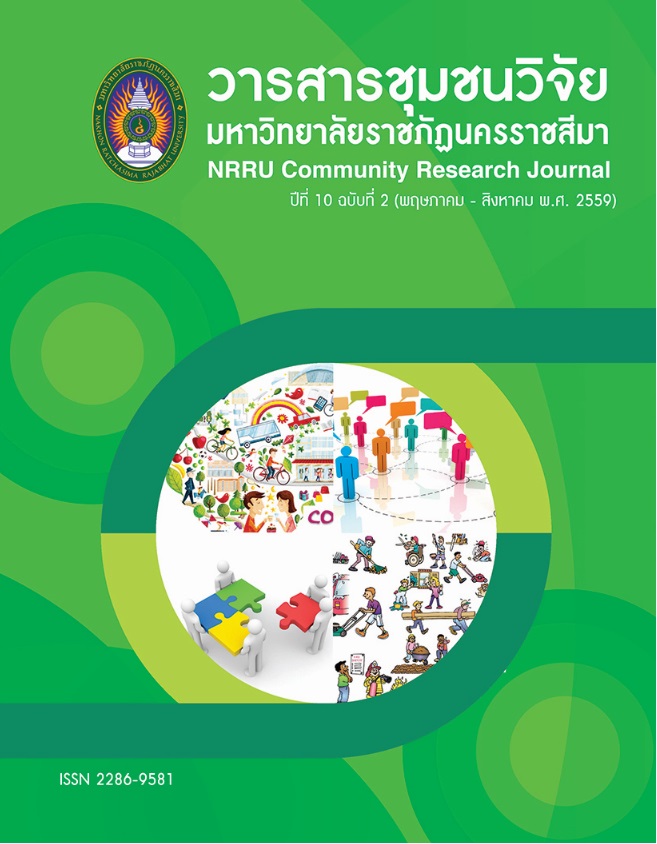การพัฒนารูปแบบการป้องกันการแพร่ระบาดของยาเสพติด ในกลุ่มเด็กและเยาวชนในเขตพื้นที่เทศบาล อำเภอเมือง จังหวัดฉะเชิงเทรา
Keywords:
รูปแบบการป้องกันยาเสพติด, การแพร่ระบาดของยาเสพติด, สาเหตุของการติดยาเสพติด, Drugs Prevention Program, Drugs Spreading, Causes of AddictionAbstract
การวิจัยครั้งนี้มีวัตถุประสงค์เพื่อ 1) เพื่อศึกษาความคิดเห็นของเด็กและเยาวชน ประชาชนในชุมชน ครู อาจารย์ และ เจ้าหน้าที่ของรัฐสาเหตุของการติดยาเสพติดของเด็กและเยาวชน ตามความคิดเห็นของเด็กและเยาวชน ประชาชนในชุมชน ครู อาจารย์ และเจ้าหน้าที่ของรัฐ 2) เพื่อศึกษาปัญหาและอุปสรรคในการปฏิบัติหน้าที่ของเจ้าหน้าที่ของรัฐที่มีส่วนเกี่ยวข้องกับการ ป้องกันและปราบปรามยาเสพติด 3) เพื่อพัฒนารูปแบบที่เหมาะสมในการป้องกันการแพร่ระบาดของยาเสพติดในเขตเทศบาล อำเภอเมือง จังหวัดฉะเชิงเทรา การศึกษาครั้งนี้ใช้วิธีการวิจัยแบบผสมผสานระหว่างการวิจัยเชิงปริมาณและการวิจัยเชิงคุณภาพ กลุ่มตัวอย่าง คือ เด็กและเยาวชน ในเขตเทศบาล อำเภอเมือง จังหวัดฉะเชิงเทรา จำนวน 200 ราย และทำการสุ่มแบบลูกโซ่ (Snowball Sampling) และสัมภาษณ์เชิงลึกเด็กและเยาวชน ประชาชนในชุมชน ครู อาจารย์ และเจ้าหน้าที่ของรัฐที่เกี่ยวกับ การป้องกันแก้ปัญหายาเสพติด
จากผลการวิจัยพบว่า
1. การติดยาเสพติดของเด็กและเยาวชนมีสาเหตุมาจาก 1) สภาพแวดล้อมในชุมชนมีแหล่งซื้อขายยาเสพติดอย่าง แพร่หลาย 2) การได้รับแรงสนับสนุนจากสังคมเพื่อนที่ติดยาเสพติด 3) การเลียนแบบเพื่อนที่ติดยาเสพติด 4) สถานศึกษา ขาดสถานที่ที่จะมาช่วยผ่อนคลายความเครียดให้กับนักเรียนนักศึกษา 5) นักเรียน นักศึกษาเป็นอยู่ในวัยที่อยากรู้อยากลอง 6) มีปัญหาครอบครัวแตกแยก และ 7) การรับรู้ข้อมูลข่าวสารผิดๆ เกี่ยวกับยาเสพติด
2. ปัญหา อุปสรรค ในการปฏิบัติหน้าที่เจ้าหน้าที่ของรัฐคือผู้บริหารสถานศึกษาบางแห่งขาดความมุ่งมั่น และเอาใจใส่ ในการป้องกันหรือแก้ปัญหายาเสพติดในสถานศึกษา และการที่เจ้าหน้าที่ของรัฐจะบอกว่านักเรียนคนใดในโรงเรียนใดติด ยาเสพติดเป็นเรื่องที่ค่อนข้างยาก เพราะอำนาจในการควบคุมดูแลนักเรียนเป็นหน้าที่ของโรงเรียน
3. เสนอรูปแบบที่เหมาะสมในการป้องกันการแพร่ระบาดของยาเสพติด มีดังนี้ 1) สร้างเสริมการมีส่วนร่วมของชุมชน ในการป้องกันยาเสพติด 2) การจัดระเบียบสังคมแบบบูรณาการ 3) จัดโครงการโรงเรียนป้องกันยาเสพติด 4) ส่งเสริมครอบครัว สีขาวและครอบครัวเข้มแข็ง 5) การปราบปรามผู้ค้ายาเสพติดรายสำคัญและลดความเดือดร้อนของประชาชน และ 6) โครงการ บำบัดรักษาและฟื้นฟูสมรรถภาพผู้เสพ/ผู้ติดยาเสพติดแบบบูรณาการ
DEVELOPING A MODEL FOR THE PREVENTION OF DRUGS SPREADING AMONGCHILDREN AND YOUTHIN THE MUNICIPAL AREA OF MUANG DISTRICT, CHACHOENGSAO PROVINCE
The purposes of this research were 1) to study the opinions of children and youth, people in the community, teachers and government officials about the issue of the causes of drug addiction in children and youth. 2) to study the problems and obstacles to the mission of government officials who are responsible for drug use prevention and suppression, and 3) to develop an appropriate model for the prevention of the spread of drugs in the municipal area of Muang District,Chachoengsao Province. The researcher used mixed methodogies i.e. quantitative and qualitative research. The sample was comprised of 200 persons selected by snowball sampling of children and youth, people in the community, teachers and government officials whowere responsible for drug prevention and suppression. The tool used for data collectionwas a series of in-depth interviews. The collected data was subjected to content analysis.
The results of the study were as follows:
1. Drug addiction was found to be caused by 1) the environment in communities where drug trafficking was widespread 2) strong support from an addicted youth’s peer group 3) imitation of addicted friend’s behavior 4) the lack placesfor students to relieve stress in school 5) students were at the age of curiousity6) broken home problems, and 7) a perception of wrong information on drugs.
2. Problems and obstacles to the mission of government officials were that some school administrators lacked commitment and attention to the prevention and solution of drug problems in their schools. Moreover, it was quite difficult for government officials to indicate whether students were drug addicts or not since the authority for student supervision belonged to the schools.
3. Offerthe appropriate model determined for drug prevention and suppression was as follows: 1) strengthening the participation of the community in the prevention of druguse 2) integration of alienated youths in-to the social order 3) organizing school’s drug prevention programs 4) promotion of “White Family” (family without drugs) “KrobKruaKhemKhaeng” (strong family) 5) the suppression of major drug traffickers, and 6) the organization of an integrated program for drug treatment and rehabilitation.





